“Anything that makes weak - physically, intellectually and spiritually, reject it as poison.” ― Swami Vivekananda
gu
CHIT
MY FAV AD
DR
IF U WANT PSD FILES
PLEASE CONTACT : 8096027569
Thursday, May 10, 2012
Wednesday, May 9, 2012
natyam
Monday, January 16, 2012
History And Origin of Bharatanatyam
History and Origin of Bharatnatyam
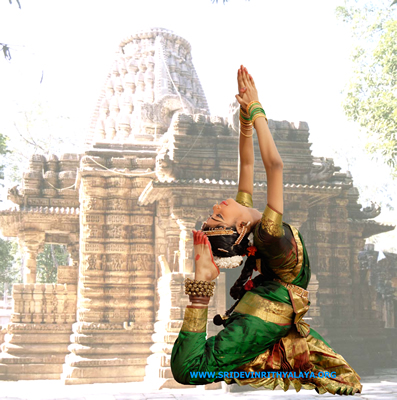
Bharata Natyam is one of the oldest dance forms of India. It was
nurtured in the temples and courts of southern India since ancient times. Later
it was codified and documented as a performing art in the 19th century by four
brothers known as the Tanjore Quartet whose musical compositions for dance form
the bulk of the Bharata Natyam repertoire even today. The art was handed down
as a living tradition from generation to generation under the Devadasi system
under which women were dedicated to temples to serve the deity as dancers and
musicians forming part of the elaborate rituals. These highly talented artists
and the male gurus (nattuvanars) were the sole repository of the art until the
early 20th century when a renewal of interest in India's cultural heritage
prompted the educated elite to discover its beauty.
By this time the Devadasis had fallen upon evil days due to lack of
state patronage and changed social mores. The revival of Bharata Natyam by
pioneers such as E Krishna Iyer and Rukmini Devi Arundale brought the dance out
of the temple precincts and onto the proscenium stage though it retained its
essentially devotional character.
Today Bharata Natyam is one of the most popular and widely
performed dance styles and is practiced by male and female dancers all over
India. Due to its wide range of movements and postures and the balanced melange
of the rhythmic and mimetic aspects lends itself well to experimental and
fusion choreography. Degree and Post Graduate courses covering the practice and
theory of Bharata Natyam as well as the languages associated with its
development are available at major universities of India.

Bharatnatyam is an artistic yoga that involves the movement of the body parts in a very artistic and elegant manner. It is the most widely practiced of Indian classical dances in south India, and has it's origin in Tamil Nadu. The term Bharatnatyam was introduced in the mid thirties by S. Krishna Iyer and later spread by Rukminidevi Arundale. It comprises of Bhava,Raga, Tala, and Natya put together as Bharatanatyam.
Natyashastra is often reffered to as the Bible of Indian classical dance. It is said that the Gods and Godesses pleaded Brahma [the creator, as per Hindu Mythology] for the creation of another Veda, that was understandable by common man. So, Brahma created the fifth Veda, which is a combination of the existing four vedas [ Rig, Yajur, Sama, and Atharva Veda]. He propogated this veda on earth through Sage Bharatha, who wrote it down as Natyashastra. Brahma took pathya [ words ] from the Rig veda, Abhinaya [ communicative elements of the body movements] from the Yajur Veda, Geeth [ music and chant] from the Sama Veda, and Rasa [vital sentiment, an emotional element] from Atharva veda, to form the fifth veda - the Natya Veda. Bharatha, together with groups of Gandharvas and Apsaras performed Natya, Nrtta, and Nrtya before Lord Shiva [the Lord of Devine Dance]. Thus Natya became the authoritative form of classical Indian dances. The term "Bharatnatyam" partly owes it's name to Sage Bharatha.
The Natyashastra reads, "when the world had become steeped in greed and desire, in jelousy and anger, in pleasure and pain, the Supreme one (Brahma) was asked by the people to create an entertainment which could be seen and heard by all, for the scriptures were not enjoyed by the masses, being too learned and ambiguous." The creation of Natyashastra is very important in the kaliyuga (the age of destruction of the world, as per Hindu mythology).

Centuries ago, there were many dancers - priestesses in the Hindu temples in south India, called Devadasis. They would sing, dance and play many musical instruments. They were well versed in Sanskrit and other languages. Since these dancers were called Devadasis, Bharatnatyam was originally called Dasi Attam. In the olden days, the Devadasis were not allowed to have families, as they led a very strict life.
The term Bharatanatyam
today identifies a particular style of dance. H
istorically, Bharatanatyam
is a system of dance, described in the Natya Shastra, capable of manifesting
various forms. Four related but distinct forms conforming to the system of
Bharatanatyam are:

- Sadir Natyam – a solo dance form performed for centuries by devadasis in temples and eventually in the royal courts of South India, especially in Tamil Nadu
- Bhagavata Melam – a group form of dance drama from Tamil Nadu, with all roles perfo
- rmed by men, and themes based on mythology
- Kuravanji –
a group dance by women, interpreting literary or poetic
 compositions
typically on the theme of fulfillment of the love of a girl for her
beloved
compositions
typically on the theme of fulfillment of the love of a girl for her
beloved - Kuchipudi – a group form of dance drama from Andhra Pradesh, with all roles performed by men, and themes based on mythology
While a number of India’s
dance forms, like Manipuri, Mohini Attam, Yakshagana, and Kathakali, can be
considered variations of the system of Bharatanatyam, they are not as firmly
rooted in it
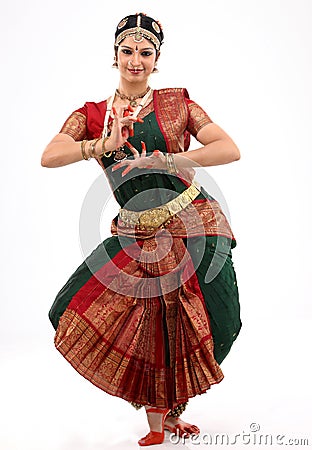
What we know as
Bharatanatyam today springs from Sadir Natyam, also known by names
like Dasi Attam, Chinna Melam, or simply, Sadir. The term Sadir began with the
Maratha rulers of South India in the 17th century, who called the dance Sadir Nautch. This corresponds to the
presentation of the dance in the courts. A more exalted role of the dance is
evoked by the name Dasi
Attam, the dance of thedevadasis as
a part of temple worship. A devadasi, whose
name means servant (dasi) of
divinity (deva), was an
artist dedicated to the services of a temple. The dance of the devadasi was integral to the
ritual worship. Devadasi families
specialized in the arts of music and dance, and with the nattuvanars (dance masters), they
maintained these traditions from generation to generation, supported by royal
patronage.
Sculptural and literary
evidence indicates that dances of the Bharatanatyam form, that is, based on
the Natya Shastra, were
used in temple worship throughout India. This original classical dance
tradition deteriorated in the North due to repeated foreign invasions, and
mixed dance forms replaced it. Fortunately, the dance tradition survived in
South India, where it continued to be patronized by kings and maintained by
the devadasi system.
This is not to say that the
tradition of Bharatanatyam was static from the time of the Natya Shastra through the last
century. It did evolve and there were regional variations in elements of the
dance. An important milestone in this evolution was the development of the
current format of the Bharatanatyam recital. This happened in the late 18th
century, at the hands of four brothers known as the Thanjavur quartet. They
were the four sons of the nattuvanar Subbarayan:
Chinnayya, Ponnayya, Vadivelu, and Sivanandam. They also refined the music of
Bharatanatyam, influenced no doubt by their musical mentor, the great composer
Muthuswamy Dikshitar. These developments shaped Sadir into the precursor of
what we call Bharatnatyam today.
Under British rule,
propaganda prevailed against Indian art, misrepresenting it as crude, immoral,
and inferior to the concepts of Western civilization. This influence was
pervasive enough to dissuade the patronage of royal courts for ritual temple
dances, and to alienate educated Indians from their traditions. The devadasi system declined. Most
were forced to seek the patronage of ordinary wealthy people, becoming
mere dasis, and in
some cases prostitutes. This in turn diminished the reputation of the devadasis as a community. Even
the terms by which the dance was known – Sadir, Nautch, Dasi Attam, and so on – took on
derogatory connotations. In the late 19th and early 20th centuries, social
reformers under Western influence took advantage of these circumstances,
launching an Anti-Nautch campaign to eradicate not only the prostitution that
had come to be associated with devadasis, but the art itself,
condemning it as a social evil. By the first quarter of the 20th century, the
classical dance of South India was almost wiped out, even in Tamil Nadu.

Against all odds, a few
families preserved the knowledge of this dance tradition. Its revival involved
individuals from disparate backgrounds: Indian freedom fighters, Westerners
interested in Indian arts, people outside the devadasi class who learnt
Bharatanatyam, and devadasis themselves.
Everyone working with classical Indian dance today owes a debt of gratitude to
these individuals, without whose efforts Bharatanatyam may have been lost.
E. Krishna Iyer was a
freedom fighter and lawyer who also had learnt Bharatanatyam. He would perform
it in female costume to remove the stigma associated with the dance, and
campaigned to raise public interest in the art. He also played a role in
founding the Music Academy in Madras (now Chennai), and used its platform to
present Bharatanatyam performances by devadasis. The public controversy
caused by the first such event made the second one a great success, and the art
gained respect due to its acceptance on the Music Academy stage.
Bharatanatyam now attracted
young artists from respectable Brahmin families. Initially
met with shock, their participation ultimately helped to shift public opinion
in favor of reviving the art. Two such women were Kalanidhi Narayanan of
Mylapore and Rukmini Devi of Adyar.
Also during this time,
Western luminaries like the ballerina Anna Pavlova were taking interest in the
artistic heritage of India, while the spiritual heritage of India was being
promoted by Westerners in the Theosophical movement.
When E. Krishna Iyer
invited Rukmini Devi to the Music Academy performance, beginning her work with
Bharatanatyam, she had already produced plays on Indian subjects and studied
Western ballet. She had trained in ballet under a pupil of Anna Pavlova’s, but
Pavlova advised Rukmini Devi to learn Indian classical dance instead. Raised in
a Theosophist family, Rukmini Devi was married to Dr. George Arundale, a
president of the Theosphical Society, and knew Dr. Annie Besant. Both Dr.
Arundale and Dr. Besant worked for India’s freedom and the restoration of its
spiritual stature. Rukmini Devi’s unique background equipped her to reform the
existing Bharatanatyam to emphasize its spirituality.
An association of devadasis joined the effort to
revive Bharatanatyam. Its ranks included an eventual teacher of Rukmini Devi’s,
as well as the family of the legendary dancer Balasaraswati. They advocated preserving
the tradition, and also keeping it in the hands of the devadasi community. Their
argument was that the art would die if separated from the caste, while
advocates for Bharatanatyam from the educatedBrahmin community argued that
the art had to be transferred to respectable hands to be saved. Ultimately,
both communities carried on with the dance. It was, after all, the devadasis and nattuvanars that trained the new
dancers from upper class society.
Rukmini Devi’s debut
performance in 1935 was a milestone. Her efforts won over much of the orthodox
community of Madras. Her reforms of costume, stage setting, repertoire, musical
accompaniment, and thematic content, overcame the objections of conservatives
that Bharatanatyam was vulgar. She went on to found the Kalakshetra institute,
to which she attracted many great artists and musicians, with whom she trained
generations of dancers.

Balasaraswati promoted the
traditional art of the devadasis,
maintaining that reforms were unnecessary and detracted from the art. Staying
true to her devadasi lineage,
she achieved great renown for her excellence.
The renewed awareness of
Bharatanatyam in Indian society allowed manynattuvanars to resume their
training activities, and many artists to enter the field of classical dance. A
diversity of styles like Pandanallur, Vazhuvur, and Thanjavur, named for the
villages from which the nattuvanars came,
became recognized. Rukmini Devi’s desire to restore the full spiritual
potential of the dance motivated reforms that led to what was known as the
Kalakshetra style of Bharatanatyam.
Bharatanatyam soon became
the most widespread and popular of the Indian classical dance forms. It wasn’t
long before it achieved international recognition as one of India’s treasures.
Recent
Changes
Compared to the millennia for which this art form has existed, the period from its revival in the 1930s through the present day has been one of explosive change. It is likely that more has changed during the past fifty years than during any other time in the history of Bharatanatyam. The modern world is a new environment for this ancient art form. For centuries, the survival of Bharatanatyam depended on a system of dedicated dancers, lifelong trainers, and royal patrons, to all of whom the dance was an integral part of social and religious life. There is no equivalent in modern society, so how is Bharatanatyam being kept alive today?
Compared to the millennia for which this art form has existed, the period from its revival in the 1930s through the present day has been one of explosive change. It is likely that more has changed during the past fifty years than during any other time in the history of Bharatanatyam. The modern world is a new environment for this ancient art form. For centuries, the survival of Bharatanatyam depended on a system of dedicated dancers, lifelong trainers, and royal patrons, to all of whom the dance was an integral part of social and religious life. There is no equivalent in modern society, so how is Bharatanatyam being kept alive today?
n the vital decades after
its revival, Bharatanatyam achieved such esteem that by the late 20th century, the
demand for learning Bharatanatyam exceeded the infrastructure to support the
art and maintain its standards. Today, it is the demand for learning it, rather
than a growth in its audience or sponsorship, that fuels the spread of
Bharatanatyam.
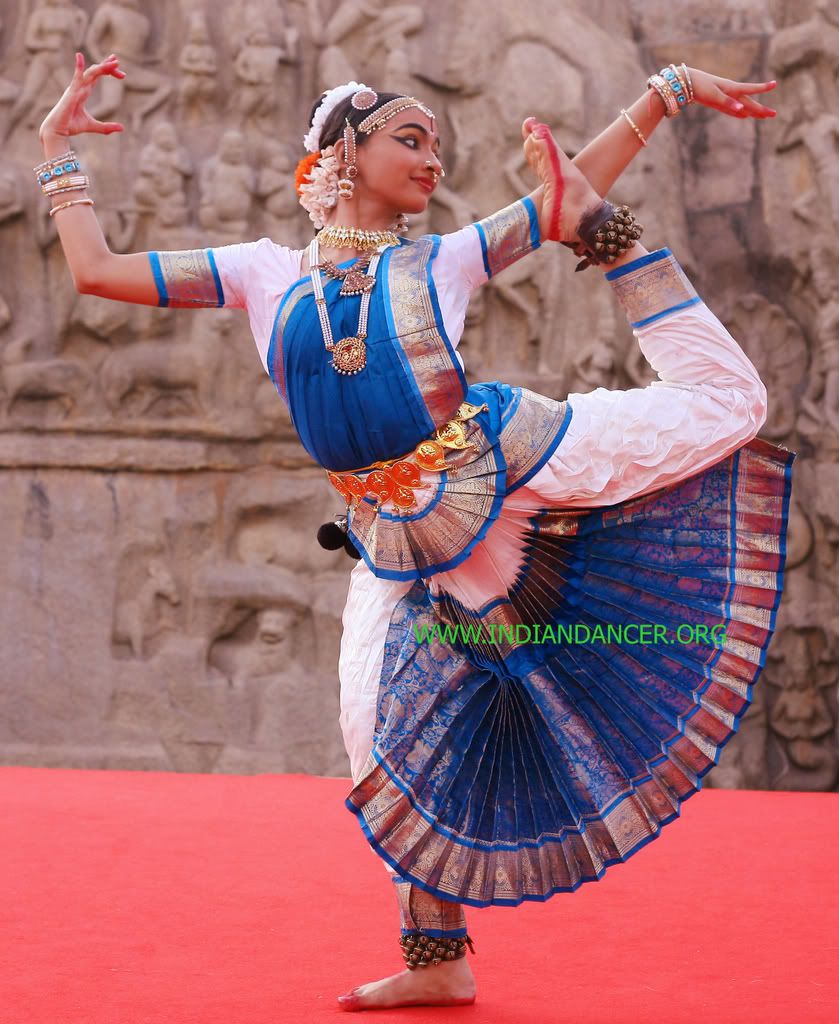
Dancers, rather than the nattuvanars, have become the custodians of the art form. The generation of nattuvanars that trained dancers during the revival period was the last generation of exclusive nattuvanars. Due to sheer numbers of aspiring dancers,nattuvanars no longer are the only trainers of dancers. In institutions like Kalakshetra, experienced dancers trained as teachers educate the next generation. But even more students now learn privately from individual dancers. The role of thenattuvanars during performances is taken by dancers or musicians with special training.

Dancers, rather than the nattuvanars, have become the custodians of the art form. The generation of nattuvanars that trained dancers during the revival period was the last generation of exclusive nattuvanars. Due to sheer numbers of aspiring dancers,nattuvanars no longer are the only trainers of dancers. In institutions like Kalakshetra, experienced dancers trained as teachers educate the next generation. But even more students now learn privately from individual dancers. The role of thenattuvanars during performances is taken by dancers or musicians with special training.
The number of dancers, or
aspiring dancers, also exceeds the availability of specialized musicians or of
patronage. Dancers often must take financial responsibility for performances,
while musicians, performance halls, and others charge fixed fees regardless of
the income generated by the performance. Many are forced to use recorded music
to keep costs down. Dancers today usually can’t make a living by performing.
With a few exceptions, Bharatanatyam is today a secondary career, or a
profession for those with family support. Few dancers can devote their entire
lives to training and developing as dancers. To earn money, dancers start
teaching early in their careers. These circumstances have created a downward
spiral of declining standards and diminishing audiences.
Without nattuvanars, and with more and more
dancers becoming teachers, the unbroken lineage of instruction that maintained
the integrity of the dance form has been lost. In the hands of many dancers
rather than a few trainers, Bhartanatyam is now subject to more numerous
innovations. Without a recognized authority, like that of the nattuvanars, to adopt or reject
changes to maintain standards, and without educated audiences to provide
meaningful feedback, the art form of Bharatanatyam is open to unrestrained
variations.

Innovation and variation
themselves are not bad. The problem is when inappropriate innovations are
claimed to be consistent with, or part of, an existing tradition. Artists have
diverse motivations, and their performances provide different experiences. To
capitalize on the reputation of Bharatanatyam for classicism and artistry,
instead of letting their innovations stand on their own merits, most artists
claim to be standard bearers of the same classical dance tradition. This
confuses audiences, and discredits the art itself.
Another recent phenomenon
is the learning of Bharatanatyam as a rite of passage for young Indian women,
especially outside India. After their arangetram, they abandon the dance.
Once the initiation of a dancer’s performing career, the arangetram has become a closing
ceremony of sorts. The income from arangetrams induces many teachers
to rush unqualified dancers to the stage. The result is a steady supply of
novice performers that don’t develop into experts capable of doing justice to
the art.
Today’s Bharatanatyam
exists in great quantity, but with a wide variation in quality. There is the
exquisite, seen rarely; there is the ridiculous, seen all too often.
Bharatanatyam’s problems today are not because of oppression, as with thedevadasis a century ago, but
due to mindless popularity and commercialization. The consequent loss of
standards means the art is often presented poorly or inappropriately, but audiences
often don’t know a good performance from a bad one. If the crown jewel of
India’s classical dances gets a reputation as a sloppy and amateurish medium,
the indifference it will elicit will threaten its survival more than any of the
challenges it has endured in the past.
Description of Bharatanatyam
Bharatanatyam has many
dimensions. They include body movements, facial expressions, hand gestures,
footwork, costumes, music, repertoire, and themes of performances. Because
Bharatanatyam is so well developed, all of these aspects of the art have been
codified, and are documented in ancient scriptures as well as recent books. Our
description of Bharatanatyam is intended for a spectator, and one who is
relatively unfamiliar with the dance, as opposed to a dance student,
professional, or scholar.
Rukmini Devi has said that
the difference between a technical expert and an artistic genius is the ability
to master the technique and then forget it. By transcending technique and
forgetting oneself, a dancer enters the spirit of the dance and expresses it.
Similarly, those of us interested in Bharatanatyam can benefit by knowing a
little about the technique and language of the art form. Otherwise, we can be
distracted or puzzled by details of technique or appearance, and miss the
deeper meaning. When we are accustomed to the mode of expression of
Bharatanaytam, then we can see beyond it, and experience what is being
expressed in the performance.
We’ll touch on the
terminology and organization of various elements of the dance, outline the
different dance items that make up a recital, and attempt to explain how they
all come together to give expression to the dancer and enjoyment to the
audience. Since our description doesn’t cover the categories of movements, expressions,
and other elements of Bharatanatyam in great depth, we’ll provide references
for further study.
We’ll focus on solo
Bharatanatyam performances for our description. What is most commonly meant by
Bharatanatyam today is a solo performance by a female dancer, although
performances by males, group dances, and even dance dramas are done under the
name of Bharatanatyam. We’ll also stick to what’s come to be generally accepted
as traditional Bharatanatyam over the past century, ignoring for now various “innovative”
mutations of the dance form.


On the surface, three
aspects of Bharatanatyam are evident, as with any dance form: movement,
costume, and music. In other words, what the dancer is doing, how the dancer
looks, and what are the accompanying sounds. We’ll describe these aspects of
the dance, and later on, attempt to explain their combined effect, which is the
intention of the dance.
Movement
There are two kinds of
movements in Bharatanatyam – abstract and expressive. The abstract movements
are done to show rhythm, to provide decoration, and to create beauty. There is
no purpose but movement for its own sake. Expressive movements convey meaning
and show emotion, through a vocabulary of hand gestures, postures, and facial
expressions. Their purpose is to portray a theme or feeling, and to transmit an
experience of it to the audience.


The movements of
Bharatanatyam are unique. They share elements with other classical Indian
dances, but aren’t found in any western dance style. They are often described
as geometric, for there is much geometry in the basic postures and movements of
which the dance is built, but this makes them sound static, which they aren’t.
Bharatanatyam is dynamic and energetic; it is also precise and balanced. The
basic postures center the weight of the dancer, and there is little use of the
hips or off-balance positions. Bharatanatyam has a variety of characteristic
movements. Along with the rhythmic stamping of the feet, there are jumps,
pirouettes, and positions where the knees contact the floor. Many are executed
in the stance with knees bent and turned outward. Performed by an expert
dancer, these movements flow together gracefully. An exceptional feature of
Bharatanatyam is the movements of the eyes, which complement and highlight the
movements of the body. Every part of the body is involved in the dance, and
their movements are defined and classified (in great number) in this system of
dance. In our description, we won’t go deep into the classifications of the
elements of Bharatanatyam. We’ll mention just enough terminology to show the
important elements that are present.
Costume


Bharatanatyam costumes for
women resemble Indian saris, but are specialized for the dance. Despite the
resemblance to saris, they are not single pieces of cloth, but combinations of
a number of specially stitched pieces. This customization makes them easier to
wear, and easier to dance in than a sari. Most costumes involve pleated pieces
at the waist than fan out attractively during various movements. The costumes
are bright and colorful. They inherit from the sari tradition the use of
contrasting border colors, and the borders of the various pieces of the
costumes form patterns that decorate the dancer’s form.

An essential item of the
Bharatanatyam costume is the pair of anklets or ankle bells (salangai in Tamil, gungaroo in Hindi). They make
the rhythmic footwork of the dance audible. Dancers treat their salangai like musicians treat
their instruments (in India, that is). The salangai are blessed by the
dancer’s guru, they are worshipped on special occasions, and are never worn
casually.


Women’s costumes involve a
significant amount of jewelry, including bangles, rings, earrings, nose rings,
and special ornaments for the arms and head.


There is, of course, makeup
for the dance, and Bharatanatyam makeup has a few unique features. Heavy lines
are drawn around the eyes, extending outwards past the eyes. Similarly, the
eyebrows are darkened and extended outwards with liner. The purpose of this makeup
is to accentuate the movements of the eyes and eyebrows, and make them more
visible, because they are an important part of the dance, especially for
expression. A red dye is applied to the soles of the feet and the tips of the
toes, as well as to the fingertips. It is also painted in a solid circle in the
palm of each hand. This unique decoration serves to emphasize the movements of
the hands and feet.




The costumes of men are
simpler, usually a dhoti covering the lower body and no upper garment. The men
also wear ankle bells or salangai. They
wear much less jewelry than women. Men do apply the same makeup to the eyes as
women, since it serves an important purpose in the dance, but not to the hands
and feet.


The Bharatanatyam costume
is intended to look beautiful. It was the dress worn to dance for gods in
temples, or for kings in palaces. When a dancer enters, the costume leaves no
doubt that it is a special occasion.


Music
Bharatanatyam is
accompanied by music of the Carnatic style, that has been specialized for
dance. The music is specialized in a few ways.
- In a music concert, the musician’s talent is displayed; in a dance performance, the musicians must focus on accompaniment and support the dancer. Excessive ornamentation and improvisation in the music distracts from the dance. Improvisation is left to the dancer, in particular phases of items. The musicians must be able to take cues from the dancer to make impromptu adjustments.

- The range of tempos in the music is limited to what a dancer can physically handle. The percussionists must also play so that they emphasize the beats that are important to the dancer, and avoid virtuoso demonstrations that don’t support the dancer.
- The musical group for a dance performance includes someone capable of doingnattuvangam, that is, calling out rhythmic syllables that denote dance movements, and striking cymbals on particular beats as cues to the dancer. This skill usually belongs to dancers and dance teachers, and not to concert musicians.
Bharatanatyam goes hand in
hand with Carnatic music. Many dance items, like thepadam, varnam, kirtanam, and tillana, share their names with
musical items that have the same structure. The thematic content of the music
and dance are the same. This is natural, as both art forms are South Indian in
origin.
Music that is composed for
dance items typically makes use of rhythmic patterns (talas) and melodies (ragas) that suit the theme of
the dance. The synergy between the music and dance is important in transmitting
an experience of the theme to the audience. The expressive power of Carnatic
music is such that often the music alone can move the audience. Depending on
how you look at it, this either frees the dancer of the responsibility to
deliver a strong performance, or challenges the dancer to do justice to the
music.
Now we’ll encounter some
terminology and classifications. The terminology is necessary to describe some
deeper aspects of Bharatanatyam, and the classifications of various facets of
the dance illustrate how well developed an art form it is.


Nritta, Nritya, Natya
At the functional level,
the dance has three aspects:
- Nritta: Abstract dance movements with rhythm, but without expression of a theme or emotion. Also called pure dance.
- Nritya: Interpretive dance, using facial expressions, hand gestures, and body movements to portray emotions and express themes.
- Natya: The dramatic aspect of a stage performance, including spoken dialogue and mime, to convey meaning and enact narrative.
Despite some overlap between natya and nritya, they differ in that natya does not include
dance, and nritya does
not include speech. While Bharatanatyam includes the mimetic and narrative
aspects of natya, it does
not use spoken dialogue. The definitions of terms like nritta, natya, and nritya are not critical for
a spectator, but it’s good to know that these elements are present as features
of the dance. In different Bharatanatyam numbers, the balance between nritta, natya, and nrityavaries. In general, the
dominant aspect of Bharatanatyam is nritya.
One way to tell whether a
dancer is doing nritta or nritya is by the music. The
music for passages of pure nritta does
not have lyrics; the names of rhythmic beats are called out, or the names of
musical notes are sung. For interpretive dance withnritya and natya components, lyrics
with meaning are sung, and the dance expresses the sentiment or the meaning of
the lyrics. Another way to distinguish nritta andnritya is by the facial
expressions of the dancer. Nritta is
usually done with a smile, and despite eye movements, the face maintains a
stable emotion. In nritya, various
expressions cross the dancer’s face, showing different emotions. All the parts
of the face may be active in displaying the emotions. There are Bharatanatyam
items that are entirely abstract, and others that are entirely interpretive,
but most of them include elements of nritta and nritya, often in alternating
passages.


Dance
Vocabulary of Bharatanatyam
Bharatanatyam has a rich
language of expression. Let’s look one level deeper, into the building blocks
of the dance, the words and letters of the language. Both nrittaand nritya are achieved by a
combination of movements and positions involving the feet, limbs, and body,
along with hand gestures and facial expressions. These elements are well
defined, and constitute a vocabulary that characterizes Bharatanatyam. Natya is achieved through
portrayal of characters and themes, which are also described in scriptures.
Scriptures like the Natya
Shastra and Abhinayadarpana classify the elements of dance in great detail and
in large arrays; we’ll point you to the books to study them further. For now,
we’ll just mention various categories of Bharatanatyam elements, so you’ll know
they exist, and can notice them in the dance.

The basic unit of dance in
Bharatanatyam is the adavu.
Each adavu is
a combination of steps or positions with coordinated movements of the feet,
legs, hands, arms, torso, head, and eyes. Adavus give Bharatanatyam
its distinctive look. For instance, many adavus are executed with the
legs bent, knees outward, heels together and toes outward – a position
called araimandi.
The adavus,
numbering around 120 in all, are divided into numerous groups and subgroups.
Some adavus are
accompanied by rhythmic syllables, or sollukattus, that put together the
steps of the adavu in
a time sequence or meter. Sollukattu, which
in Tamil means spoken (sol)
structure (kattu), is a
verbal description of an arrangement of beats or steps. For example, the
phrase, “thai-yum-that-that thai-yum-tha” is the sollukattu for an adavu named Nattadavu.
Various sollukattus have
phrases like “thai-ya-thai-yi”, “tadhing-gina-thom”, and
“kita-thaka-thari-kita-thom”. If you ever watch a Bharatanatyam class, you’ll
hear many such phrases being called out by the teacher as the students
practice adavus.
The hand gestures of
Bharatanatyam are called hastas.
Sometimes, you may hear them called mudras, or hasta mudras. There are one-handed and
two-handedhastas, there
are lots of them, and they all have names. When a hasta is employed in a
specific context for a specific purpose, it gets a special name for that use.
For example, the Tripataka hasta is
a gesture in which the hand and fingers are held flat, with the ring finger
bent at the knuckle so that it is perpendicular to the palm. This is the
position of the hands in Nattadavu, and for this application, and any
other nrittaapplication,
it is called Tripataka or Tripataka hasta. When it is used in nritya to denote fire, or to
portray a tree, it is still called Tripataka hasta, but when it is used to
denote Vishnu, it is called Vishnu hasta. In general, when
the hastas are
used to denote deities, celestial bodies (like the nine planets), or relations,
their names are changed according to the application. All the hastas find use in nritya, but only a subset of them
are used in nritta; these
are also called nritta hastas.
During nritta,
the hastas convey
no meaning. They are purely decorative. In nritya, the hastas are a vital aspect of
the expressive language of the dance. They describe things and objects, they
express concepts like truth, beauty, or the passage of time, they depict
thoughts, words, and actions, and they combine with facial expressions to show
emotions. The same hasta, used
with different arm movements or in a different context, can have a different
meaning. This is how the Tripataka hasta can be used for fire
or a tree, and can also become the Vishnu hasta. This is just a simple
example; most hastas have
dozens of different uses.

The facial expressions of
Bharatanatyam are called abhinaya. (To be
precise,abhinaya is
the art of expression, and facial expressions are one aspect of abhinaya, but the term abhinaya is commonly used to
refer to facial expressions. We’ll discussabhinaya further in its own
section later.) The dancer uses facial expressions to show emotions. The
emotions may come from the poetry in the music, or belong to a character being
portrayed. The expressive aspect of the dance is the means by which the dancer
can communicate an inner experience to the audience. The emotions shown by the
dancer create a response in the audience, an experience of feeling or
sentiment. Bharatanatyam scriptures have organized the process by which
sentiment is produced, and categorized the different types of aesthetic
emotions. Each sentiment is associated with causes, consequences, and passing
feelings, all in the presence of a dominant emotion. The dancer may enact many
passing feelings (called sanchari
bhava) to show the effects (called anubhava) produced by the causes
(called vibhava) of the
emotional state, and to reveal the fullness of the dominant emotion
(called sthayi bhava). For
example, to describe a main emotion of love, the dancer may portray various
transitory feelings like impatience, weakness, excitement, anxiety, and so on,
to suggest the longing for one’s beloved. In Bharatanatyam, there are nine
emotions – shringara (love,
eros), vira (valor,
heroism), karuna (sadness), adbhuta (awe,
amazement), raudra (fury), hasya(laughter, humor), bhayanaka (fear), bibhatsa (revulsion),
and shanta (peace)
– and countless passing feelings that may be enacted. The portrayal of feelings
in abhinayais
stylized rather than literal. For example, to illustrate sadness by describing
the flow of tears, a Bharatanatyam dancer doesn’t actually shed tears (as a
movie actor would), but indicates the flow of tears using hand gestures
combined with facial expressions.
In addition to the
fundamental emotions, categorized in the Natya Shastra and other
scriptures, the vocabulary of Bharatanatyam includes a variety of characters,
and their associated qualities, that are used to develop themes. The nayika or heroine, the nayaka or hero, and
the sakhi or
friend, are examples of such characters. TheNatya Shastra lists eights
types of nayikas based on their emotional circumstances. In addition, there are
categorizations like the ten graces of women, the ten stages of love, and so
on. Characters may also be classified according to their stature, asuttama (noble, divine), madhyama (human), and adhama (base), as well as
according to their moral disposition, as swakiya (faithful
wife), parakiya (married
but longs for another), and samanya (courtesan).
The stature and qualities of characters influence which emotions they
experience, modify the emotions they do experience, and determine their
responses to different circumstances. Without going into all the details and
definitions of character that are documented, we can see by the attention given
to the nuances of emotion and character, that the portrayal of various states
and moods is the subject of great artistry in Bharatanatyam. It extends the
language of Bharatanayam into the realm of poetry.
We’ve touched on a few of
the most prominent aspects of the dance vocabulary of Bharatanatyam, without
going into much depth. There are many details that we haven’t covered.
Nevertheless, we can begin to how these elements fit together as building blocks
for the dance. Adavus and nritta hastas are the foundation
of nritta.Adavus and the full range
of hastas,
together with abhinaya, make
up nritya. The use
of abhinaya and
character provides the dramatic element, or natya. This is certainly a
simplistic explanation, but it illustrates the depth of the Bharatanatyam
vocabulary. Each basic element in the list is a deep subject in its own right.
Simplistic
Breakdown of Bharatanatyam

The abstract movements
of nritta create
an array of rhythmic patterns, shapes, and forms in coordination with music.
The movements and music complement each other, displaying the beauty of the
dynamic abstract form. To appreciate how these elements come together, it helps
to know some of the concepts or structures being employed by the musicians and
dancers. We mentioned earlier that you can recognize nritta when the singer sings
the names of notes or the nattuvanar calls
out rhythmic syllables. Of course, for this you need to be able to recognize
the solfa syllables of the notes, or the syllables that denote beats. We’ll
briefly look at the source of these syllables in music and dance, and then
show nritta uses
them.
Rhythmic
Structure
In Carnatic music, the
rhythmical structure of a composition is made up of patterns called talas. The closest concept
to tala in
Western music is meter, but it’s not exactly the same. A repeated cycle
of tala consists
of a number of equally spaced beats, which are grouped into combinations of
three patterns. These patterns are the laghu, dhrutam, and anudhrutam. By the way, if you watch
people keeping time at an Indian classical music or dance recital, the specific
way they mark beats by tapping their laps with their fingers, palm, and back of
the hand, are determined by these patterns of the tala.
- A dhrutam is a pattern of two beats, denoted by “0”.
- An anudhrutam is a single beat, denoted by “U”.
- A laghu is a pattern of 3, 4, 5, 7, or 9 beats, denoted by “1”, and the specific number characterizes the type or jaathi of the tala.
There are seven families
of talas,
depending on the arrangement of patterns in a cycle.
Name
|
Pattern Sequence
|
Abbreviation
|
Default Laghu
|
Dhruva
|
laghu-dhrutam-laghu-laghu
|
1011
|
4 beats
|
Matya
|
laghu-dhrutam-laghu
|
101
|
4 beats
|
Rupaka
|
dhrutam-laghu
|
01
|
4 beats
|
Jhampa
|
laghu-anudhrutam-dhrutam
|
1U0
|
7 beats
|
Triputa
|
laghu-dhrutam-dhrutam
|
100
|
3 beats
|
Ata
|
laghu-laghu-dhrutam-dhrutam
|
1100
|
5 beats
|
Eka
|
laghu
|
1
|
4 beats
|
According to the number of
beats in the laghu, the
five different jaathis have
their own names.
3 beats
|
Tisra
|
4 beats
|
Chatusra
|
5 beats
|
Khanda
|
7 beats
|
Misra
|
9 beats
|
Sankeerna
|
The jaathi is also known by the
term chaapu in
Carnatic music.
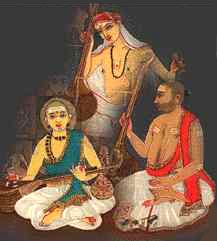
Each of the seven tala families has a
default jaathi associated
with it, as listed in the table above, which is implied when no jaathi is specified. Thus
Triputa tala by
itself means Tisra-jaathi Triputa tala. Furthermore, since
Eka tala consists
of a singlelaghu, talas in this family are
sometimes called only by the jaathi name.
For example, Misra Chaapu is a common name for Misra-jaathi Eka tala.


Based on the tala families and laghu lengths, there are 7
x 5 = 35 talas. The
shortest is Tisra-jaathi Eka tala at 3 beats and the
longest is Sankeerna-jaathi Dhruva tala at 29 beats. Note
that there are instances where multiple talas have the same number
of beats. For example, Tisra-jaathi Triputa tala has seven beats, just
like Misra-jaathiEka tala. From a dancer’s
perspective, talas with
the same number of beats are identical, but a percussionist will play them
differently. The beats may have different emphasis, or may be played with
different drum notes.
Each beat may be further
divided into a number of counts. The number of counts per beat is called
the nadai or gati of the tala, and can
be 3, 4, 5, 7, or 9. The default is 4. The names Tisra, Chatusra, Khanda,
Misra, and Sankeerna, are used for the nadaias they are for the jaathi. Thus, Chatusra-nadai Khanda-jaathi Ata tala has 5 + 5 + 2+ 2 = 14
beats of 4 counts each, for 56 counts. It could also be called Chatusra-gati Khanda-chaapu Ata tala. With the defaults
for nadai and jaathi, it could also be called
simply Ata tala.
There are actually many
more talas than
the 35 that arise from the seven families mentioned above. Most are not used outside
of elite music performances. The most popular talas have short aliases.
For example, Chatusra-nadai Chatusra-jaathi Triputa tala, an
eight-beat cycle, is simply called Aadi tala. Some of the most
common talasfor
Bharatanatyam are Adi, Rupaka, and Mishra Chaapu.
The tempo, or kaala, of the rhythm is
independent of the tala. There
are three speeds used for dance: slow (vilamba), medium (madhya), and fast (drut). Medium is double the
speed of slow, and fast is four times the speed of slow.
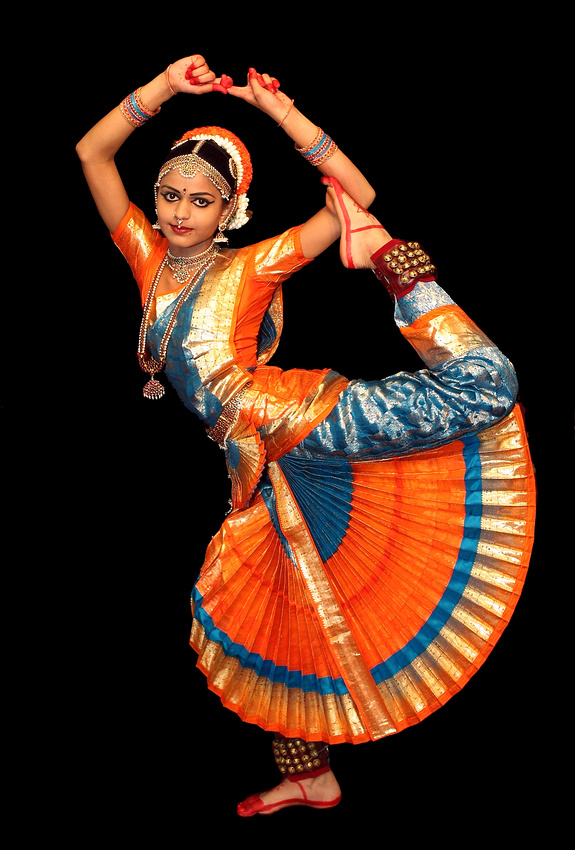
Sources of
Syllables
The syllables used to
accompany nritta come
from four sources: rhythmic beats of the tala, drum beats from percussion,
musical notes, and steps of the adavus.
Within the tala, the beats
in each jaathi are
given syllables that are used in dance.
3 beats
|
Tisra
|
tha-ki-ta
|
4 beats
|
Chatusra
|
tha-ka-dhi-mi
|
5 beats
|
Khanda
|
tha-ka tha-ki-ta
|
7 beats
|
Misra
|
tha-ka dhi-mi tha-ki-ta
|
9 beats
|
Sankeerna
|
tha-ka dhi-mi tha-ka tha-ki-ta
|
In addition to the
syllables used for the beats in each jaathi, there are syllables for
the dhrutam and anudhrutam. The anudhrutam is a single beat,
denoted by “tha”. The dhrutam is
two beats, denoted by “tha-ka”, but if two dhrutams are together, the four
beats are denoted by “tha-ka dhi-mi”. For the counts in the nadai, if it is actually being
called out, the same syllables of the jaathi are used. Thus, there
is a full set of syllables to denote all the specific beats of a rhythmic
cycle.
The drums used for Indian
music can produce a variety of sounds, and are even tuned to match the pitch of
the music. Bharatanatyam almost always uses themridangam for percussion. To
account for various sounds or voice of the drum, percussionists use an expanded
set of syllables beyond what is used to describe thetala alone. Their
vocabulary adds syllables like “dheen”, “dhin”, “gin”, “jhum”, “na”, “num”,
“ri”, “thi”, and “thom” to the tala syllables. The
term jati, is used
to refer to drum syllables, or sequences of drum syllables.
The musical notes of the
scale are designated by the syllables “sa-ri-ga-ma-pa-da-ni-sa”. These are like
the solfa syllables “do-re-mi-fa-so-la-ti-do” in Western music, although the
system of scales is different. The syllables for the musical notes are
called swaras. In
music concerts, singers have various ways of singing melodies without lyrics,
one of which is singing the swaras. During
dance, melodies without lyrics almost always sung with swaras. The exception is during
a tillana, a dance
item that shares its name with a type of musical composition. South
Indian tillana singing
is based on the North Indian practice of tarana, in which most of the
syllables used are from the tabla, and
certain syllables are used often because they sound pleasant. In a tillana, these special rhythmic
syllables are sung with a melody.
Finally, the sollukattus associated with
dance adavus provide
another set of syllables. This set includes more syllables that sound like the
striking of the floor with the feet, like “tham”, “thai”, and “thath”.
The adavu sollukattus differ
from the other sources of syllables mentioned above in that they are linked
directly to the dance movements rather than to the music.
Rhythmic
Compositions in Nritta
The abstract dance of nritta involves movements
performed to the accompaniment of rhythmic sounds, which may be melodic or
purely rhythmic. There are many ways to blend the movement and sound for
artistic effect. We’ll briefly mention a few specific features of nritta compositions, since
they appear in certain Bharatanatyam items that we’ll describe later. These
features are defined by the combination of rhythmic music and dance movements.
Therefore, our description of them focuses on the rhythm of the movements,
rather than the forms and shapes of the movements themselves. (Description of
the movements in words is difficult, even with lots of references to adavus, and a comprehensive study
of the adavus and
movements is left to serious students.)
The music compositions for
Bharatanatyam allow passages of abstract dance to be interposed in the
performance. During these passages, the nattuvanar who conducts the
dance intones the rhythmic syllables and the dancer dances to them. The
sequences of syllables from the nattuvanar are called
sullokattus or jatis(disregarding
the specific meanings of these terms in the context of adavus or percussion). It is
common for nattuvanars to embellish the syllables, or even invent ones of their
own, to achieve a desired effect. A phrase like “dhanuku-jhonuku-tham
dhrugu-thaka dhrugu-thaka-thai” is clearly rooted in the basic tala or adavusyllables, but sounds
better.

A passage of rhythmic
syllables during the recital is called a teermanam. The artistry in composing
a teermanam is
in the interaction of the jati passage
with the rhythm of the musical composition. Teermanams frequently involve
cross rhythms. A simple example is a teermanam in triple time during
a musical composition in four time, where the length of the teermanam would be twelve beats
(or another suitable multiple). The dancer would switch rhythms during
the teermanam to
follow thenattuvanar. Such
compositions allow a greater variety of adavus to be used in the
dance choreography, since adavus are
associated with specific rhythms. A pleasing composition balances variety with
grace, using the interplay of various movements, diverse rhythms, and the three
different speeds for a complementary effect.
The rhythmical movements
of nritta may
also be performed to the accompaniment ofswaras, the syllables of musical
notes sung by the singer. A particular Bharatanatyam item consisting of
pure nritta danced
to swaras is
called thejatiswaram. The
choreography of movements for a jatiswaram takes into account
the mood of the musical composition, so that there is harmony in the item.
There are instances of dancing to swaras during other items,
like varnams, but
these instances are not called jatiswarams. The term swarajati refers to something
quite different – a musical composition in which there are swara and jati combinations, but
that is distinguished by the singing of the rhythmic syllables with a melody.
Dances have been composed for these musical items, but they are not as common
as jatiswarams.
The composition of
rhythmical movements is a combination of adavus, which are basic dance
units. Sometimes, these adavu sequences
are called adavu-jatis. Another
term worth mentioning is a korvai, which
is a collection of adavu sequences
that corresponds to a verse or section of the music.
Even though nritta is abstract, the
combination of swaras and jatis with dance movements
does produce a feeling. When nritta passages
are included in expositorynritya dance
items, the nritta choreography
is done in harmony with the mood of the item, or the qualities of a character
being portrayed. Dance with vigorous, brisk movements is called Tandava, and it has various types,
such as Ananda Tandava, which
is performed with joy, and Rudra Tandava, performed with anger or
violence.Tandava is
considered masculine, and its feminine counterpart is called Lasya. The movements of Lasya are graceful, fluid,
and tender. Thus, even in abstract dance without the use of abhinaya, the mood evoked by pure
movements in coordination with music is taken into account for a congruous
composition.
Bharatanatyam’s most
powerful feature is its ability to express meaning and emotion, and to transmit
an experience to the audience. This is a profound subject, of which we’ll just
touch the surface, by looking at two of its aspects. One is the art ofabhinaya, and the other is the
blending of music and dance to express more than either could alone.

Abhinaya
Abhinaya was
mentioned earlier in the context of facial expressions, but in reality it is
much more. It refers to the art of expression, as well as transmitting an
experience to the audience. Thus, it enters all aspects of the dance,
including nritta, nritya, and natya. Abhinaya is a distinguishing
characteristic of Bharatanatyam; it goes beyond conveying an abstract aesthetic
experience, beyond narration, beyond showing a story unfolding, and expresses
the inner experience of the dancer, or the character portrayed by the dancer.
To be believable, the dancer must truly enter the spirit of what is being
portrayed. How fully the dancer is expected to embody the subject will be
evident from a brief description of the different aspects of abhinaya.
- Angika (body)
- Vachika (voice)
- Aharya (costume)
- Satvika (state)
Angika relates
to body movements, which are the primary means of expression in Bharatanatyam.
The relationship of every movement to the emotions is taken into account.
Movements are classified as belonging to the angas or major parts of the
body, pratyangas or
intermediate parts of the body, and upangas, which include the
extremities and facial features. Thus, the entire body of the dancer is a
vehicle for expression. Angika also
covers the previously mentioned hand gestures and eye movements.
Vachika relates
to expression through speech or song. Dialogue is used in dramas, and also
in Bhagavata Melam and Kuravanji performances, but not
in Bharatanatyam recitals. In Bharatanatyam, vachika pertains to how the
singer expresses the emotion through the music. The practice of dancers singing
while enacting abhinaya existed
in Balasaraswati’s time, but is hardly ever seen now. Thus vachika is now the domain of
the vocalists who accompany the dancers.
Aharya relates
to expression through costume, jewelry, and make-up. These elements should be
designed to complement the emotions being expressed by the dancer and the
singer.
Satvika relates
to the expression of emotional states that result from circumstances or events.
The dancer embodies the emotion through appropriate facial expressions and body
movements. The emotions portrayed by the dancer must be in harmony with those
expressed by the music, to create the right mood. The authenticity with which
the dancer expresses emotion, and the dancer’s ability to enter the spirit of
what is being portrayed, determines how well the audience will be engaged, and
what kind of response will be elicited in them.

All four types of abhinaya may be used in
combination, and in differing amounts, to achieve a believable and moving
performance.
Understanding the different
types of abhinaya helps
you appreciate more fully what is being expressed in the dance. For angika abhinaya, knowing the language of
gestures is the key. For vachika
abhinaya, you should understand the lyrics of the music. Even with an
incomplete understanding of these modes of expression, you can follow much of
the content if you know the story, context, or theme of the performance.
For aharya abhinaya, an
aesthetic sense is sufficient. Some familiarity with the Indian style of dress
and decoration helps, so that the costumes don’t seem so unusual that they are
distracting. Satvika abhinaya evokes
a response to the emotional state of the dancer. To some extent, this happens
naturally and intuitively, but understanding the techniques of angika, vachika, and aharya abhinaya can make the
difference between the form of the dance interfering with the experience or
enhancing it. Ideally, for both the dancer and the audience, the dance form or
technique is a means to an end, which is to transcend the form, and go beyond
it to the inner experience.
Synthesis
of Music and Dance
For expressive dance,
lyrics are sung, and their meaning is brought out by the dance. In addition to
the rhythmical aspects which we have discussed, the elements of melody and
poetry are important.


The term raga refers to the melodic
scale of the music, and ragas are
a separate topic for study in Indian classical music, both Carnatic and
Hindustani. For our purposes, it’s enough to know that different ragas, or melodic patterns of
notes, are ascribed different moods or sentiments. Thus, the choice of raga for a dance item
should suit its theme. This is why certain types of dance items favor
certain ragas. For
example, a shabdam is
a dance item of praise or salutation, and the majority of them use a raga called Kambhoji.
The poetic content of the
music is called sahitya. Sahitya means more than just
the lyrics, it also refers to prosody, the system of poetic meters and
versification. In Carnatic music, the blending of beautiful music and exquisite
poetry is done with great artistry. The syllables of the sahitya merge with the
musical setting to create the full effect. A mark of great composers is that
their sahitya can
reveal facets of the raga or
bring out its essence. Similarly, the sahitya of the music for
Bharatanatyam contributes to the feeling of the dance item, along with the
melody and rhythm.
The union of music and
dance in Bharatanatyam is such that the whole is greater than its parts. In the
same way that the teermanam employs
rhythmic sollukattusand dance
steps that are variations on the rhythm of the musical composition, theabhinaya of the dance rendered
in expository gestures and facial expressions, depicts variations on the theme
in the sahitya of
the music. A musical composition may use the same lyrics in several
repetitions, varying the melody or emphasis, while the dancer uses different
mimetic language to describe a different aspect of the theme in each
repetition. Thus the dance extends the poetic theme of the music. The result is
a more profound expression of meaning or emotion, a more moving experience for
the audience.
The sequence of items in a
Bharatanatyam concert program is called the margam. The traditional solo
recital has a typical sequence of items, which we outline here.
The present form of the
solo Bharatanatyam recital is said to have been a refinement of the famous
Thanjavur quartet brothers Chinnayya, Ponnayya, Vadivelu, and Sivanandam,
masters of music and dance during the late 18th century. Throughout its two
thousand year history, Bharatanatyam has been an evolving art, not stagnant. The
fine-tuning of the Bharatanatyam program by the Thanjavur quartet happening
during a period in which both Carnatic music and dance underwent refinements at
the hands of various master artists. Various authors describe the motivation
for their reform of the Bharatanatyam program differently, for example, to be
able to include the various styles of dance composition in a single recital to
please the royal court of Thanjavur, or to bring out the nritta, abhinaya, and nritya features of the
dance. The facts surrounding its origin may be uncertain, but the arrangement
was good enough to have persisted through the present day. Despite the
innovative tendencies of modern dancers, recent changes to the recital format
have been either minor or transitory.
The solo Bharatanatyam
recital has a structure and a progression of items. There are items meant for
the beginning of the performance, a main item at its center, and items
typically performed after the main item. The names of the typical items, in
sequence, are
Item
|
Aspect
|
Emphasis
|
Alarippu
|
Nritta
|
Invocation
|
Jatiswaram
|
Nritta
|
Melody, Rhythmic Movement
|
Shabdam
|
Nritta and Nritya
|
Salutation
|
Varnam
|
Nritta and Nritya
|
All Aspects of Dance
|
Padam
|
Nritya
|
Expression, Exposition
|
Ashtapadi
|
Nritya
|
Expression, Exposition
|
Kirtanam
|
Nritya
|
Expression, Devotion
|
Javali
|
Nritya
|
Expression, Exposition
|
Tillana
|
Nritta and Nritya
|
Nritta
|
Shlokam
|
Nritya
|
Devotion
|
Mangalam
|
Nritya
|
Benediction
|
Before dance practice or a
recital, it is traditional for a dancer to make obeisance to the gods, the
earth, and the guru. The vandana or namaskaram is the ritual
practice of bowing before dancing. At a recital it is usually done backstage.
A pushpanjali is
the offering of flowers to a deity, as another form of obeisance. Despite a
recent tendency of dancers to make a performance item out of a pushpanjali, it is not a traditional
dance item and it is not the same as, nor a substitute for, the alarippu.
There is some flexibility
in the interpretive items that follow the varnam. Not all recitals have
one padam,
one ashtapadi,
one kirtanam, and
one javali. Each of
these items is optional, although it’s typical for there to be two or three of
them in the recital. It could be, for example, two ashtapadis and a padam. The recital traditionally
ends with a shlokam or
a mangalam, but
usually not with both.
Next, we’ll describe each
type of item from the margam briefly.
Alarippu
The first item of a
recital, the alarippu is
a short and simple item, but is significant as a ritual dance prelude to the
performance. Its primary intention is to invoke the blessings of the divine and
to offer homage to the audience. It sanctifies the body of the dancer and the
performance space.


A connotation of the
name alarippu is
flowering, suggesting the opening of the body and limbs in preparation for the
dance items to follow. It features a progression of movements, beginning with
the head and eyes, and then involving more and more of the body, and using more
of the performance space. The alarippu is accompanied by the sollukattus, “tham-thi-tha
thai-tha-thai”, and percussion in slow, medium, and fast tempos. The duration
of the alarippu is
about three to five minutes.
Jatiswaram
The second item is also
of nritta, or
abstract dance, but it is more complex. The dance combines rhythmic sequences
of movements in groupings of jatis. It is
performed to swara passages
in a particular raga (melodic
scale) and tala, accompanied by musical instruments. These two elements give
the item its name,jatiswaram. At the
beginning of the jatiswaram, there
is a teermanam accompanied
by sollukattus. The
rest of the item is danced to swaras.
The purpose of the jatiswaram is to create various
beautiful forms, purely for artistic pleasure. No mood or sentiment is
expressed. There are certain choreographic features that are typical of a jatiswaram – an elegant gait to
each side of the stage, for example – that contribute to its unique quality.
Shabdam
Continuing the progression
of items towards including more aspects of the dance, the third item, the shabdam, introduces abhinaya, or expressive dance. The
music includes lyrics; in a shabdam they
are in praise of a deity, a guru, or a patron (usually a king). The song may be
devotional, affectionate, or narrative in theme, and may describe the qualities,
accomplishments, and deeds of its subject. The dancer interprets the song
without elaboration.


The sahitya for a shabdam is usually simple.
There are typically two to five stanzas of poetry, with associated korvais of dance; each
subsequent one adds more detail on the same theme. There is more detail in the
poetry, more movement, and deeper expression of emotion as the item progresses.
Sometimes, the first verse is repeated as a refrain and finale, and there may
be a prelude danced to sollukattus. The
stanzas often end with words of salutation or obeisance, like “salaamure” or “namostute”. Shabdam compositions most
often use Misra Chaapu tala and
a ragacalled
Kambhoji, and a great number of them are in praise of Lord Krishna.
Varnam
The main item of the
Bharatanatyam recital is the varnam, which
reveals in full the abstract and expressive aspects of the dance, and builds on
the rhythmic, melodic, as well as lyrical aspects of the music. The structure
of a varnam in
dance is similar to that of the musical compositions that are also called varnams. The dance alternates
between passages of nritta and nritya, balancing pure dance and
expressive dance, and combining both in the final movements. The dancer
interprets the music and poetry with great elaboration in both nritta and nritya passages.
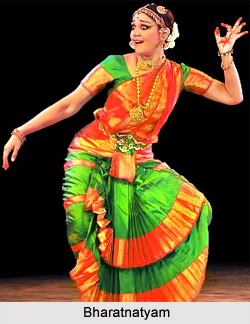

For almost every line of
the song, there will be teermanams in
various tempos, executed to sollukattus, nritta passages performed
to swara sequences,
andabhinaya sequences
that expound upon the sahitya of
the line. The nritta passages
build upon the rhythm of the musical composition and complement its melody. Theabhinaya features exposition
of the transient inner feelings, a poetry in dance that expands the poetic
theme of the music. As the varnam progresses,
the complexity of the teermanams and
the abhinaya increases,
showing the skill, versatility, and stamina of the dancer. Finally, combining
all these aspects, the dancer synchronizes rhythmic footwork of adavu-jatis, hand gestures showing the
meaning of the song, and facial expressions bringing out the subtleties of
inner emotion.

A proper exposition of
a varnam can
take forty-five minutes to more than an hour. Because it is such a strenuous
item, the varnam is
followed by a group of items that are purely expressive, and that aren’t as
physically demanding. If there is an intermission, a costume change, or a break
in the recital, it usually is right after thevarnam.
Padam
The deepest expressive item of Bharatanatyam is the padam. It is a purely expressional
piece, without nritta, and is
usually steeped with the sentiment of love and its many manifestations. It
ostensibly a love poem, with the dancer taking the role of a devotee or
heroine, but the traditional symbolism is that the heroine ornayika represents the human
soul longing for the supreme being represented by her beloved or nayaka. Typical narrative devices
include the nayika addressing
thenayaka, or
talking to her sakhi (friend)
about her love for the nayaka. The
themes of the songs may be the pain of separation from the beloved, a love
quarrel, feelings brought about by a dream of the beloved, and so on. The songs
used for padamsgive
broad scope for the expression of varying shades of emotion, and feature ragasthat match the sentiment of
the theme.

Ashtapadi
An ashtapadi is an expressive item
like a padam, but
executed to particular poetry.Ashtapadi literally
means "eight steps", from Sanskrit ashta (eight) and padi (steps), and refers
to musical compositions with eight lines, but in Bharatanatyam, it refers12th
century compositions by the Indian poet Jayadeva. His Gita Govinda uses the
relationship between the gopis (cowgirls) and Lord Krishna to symbolize the
eternal love of a devotee for the divine. Jayadeva’s poetry is well suited
to abhinaya.

Kirtanam
Another expressive
Bharatanatyam item, a kirtanam is
characterized by the devotional mood it evokes. Kirtanams use songs that
describe the virtues or acts of the gods, or devotional songs composed by great
saints. Often, the lyrics are in praise of a particular deity. Kirtanams are usually medium
tempo items with some abstract dance elements included for interest.

Javali
A javali is an expressive
Bharatanatyam number with colloquial lyrics and faster tempos than padams. Javalis usually feature
the nayika addressing
her beloved, or the divine being, from a human level. The symbolism is not
refined to the level of apadam, and the
specific types of nayikas featured in javalis differ accordingly.

Tillana
A lively item of pure nritta, the tillana is performed to music
that shares the same name. Specialized rhythmic syllables are sung to the
melody, and are repeated by the singer while the dance presents an elaboration
of the music. Each passage begins with graceful body movements, which give way
to adavu sequences
(korvais)
executed in two or three tempos, culminating in scintillating teermanams. The tillanaembodies the Lasya, or lyrical, aspect
of nritta in
its alluring poses and exquisite patterns of movement. The movements of a tillana are joyous and
expansive, giving it a vivacious quality. If the alarippu is the opening of a
flower, the tillana is
the showering of flowers throughout the performance space.
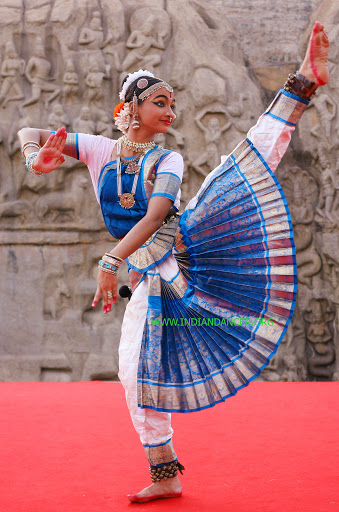
At the end of the tillana, there is often a small
sequence of nritya, in
which theabhinaya expresses
dedication to a deity or guru.
Shlokam
A shlokam is the traditional
end to a recital. A shlokam (Sanskrit
for verse) orviruttam (Tamil
for verse) is the singing of lyrics that are not set to a rhythmic pattern like
a song. The interpretation of a shlokam by a dancer and
singer is often improvisational. The dancer uses expressions and gestures to
bring out its meaning, while the music establishes the mood. The shlokam usually is of a
devotional tone, and concludes the recital with a feeling of gratitude and
serenity.
Mangalam
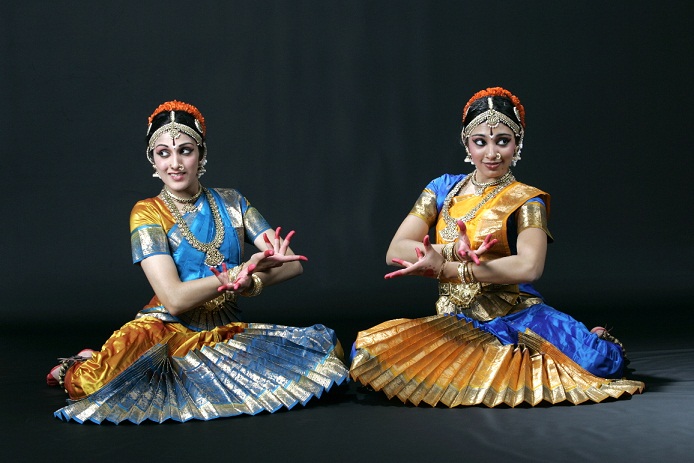
A recital that is the last
one of the day may end with a mangalam, a short benediction
during which the dancer performs the namaskaram, giving thanks and
invoking blessings for everyone present. A mangalam usually is no more
than a minute or two in duration. The music uses one of the “auspicious” ragas, typically Madhyamavathi.
We’ve briefly mentioned
many features of Bharatanatyam, showing that it has a rich language of
expression, but we’ve left an important topic for the end of our description of
Bharatanatyam - its motivation. Bharatanatyam can make the entire body of the dancer
a vehicle for expression of rhythm, melody, emotion, character, and theme. By
fully employing the techniques of Bharatanatyam, and manifesting its many
dimensions in the performance, what does the dancer aim to accomplish? What is
the purpose of the art?
Before presenting the words
of some of Bharatanatyam’s greatest artists, let’s introduce two more
terms. Bhava is
the art of expression, a key feature of Bharatanatyam. Rasa is the response or
feeling induced in the onlookers by thebhava. Although bhava is often equated with
facial expressions, it is actually much more. Bhava is the outer
manifestation of an inner experience. The inner experience leads to the
expression, bhava, and the
expression leads to the experience, rasa. The communion between the
artist and audience implied by bhava and rasa suggests the
potential for a more profound experience than mere entertainment. Whether the
full potential of the art is achieved or not in a given presentation depends on
the quality of the expression, which depends on the quality of the artist, and
on the ability of the audience to perceive and respond.
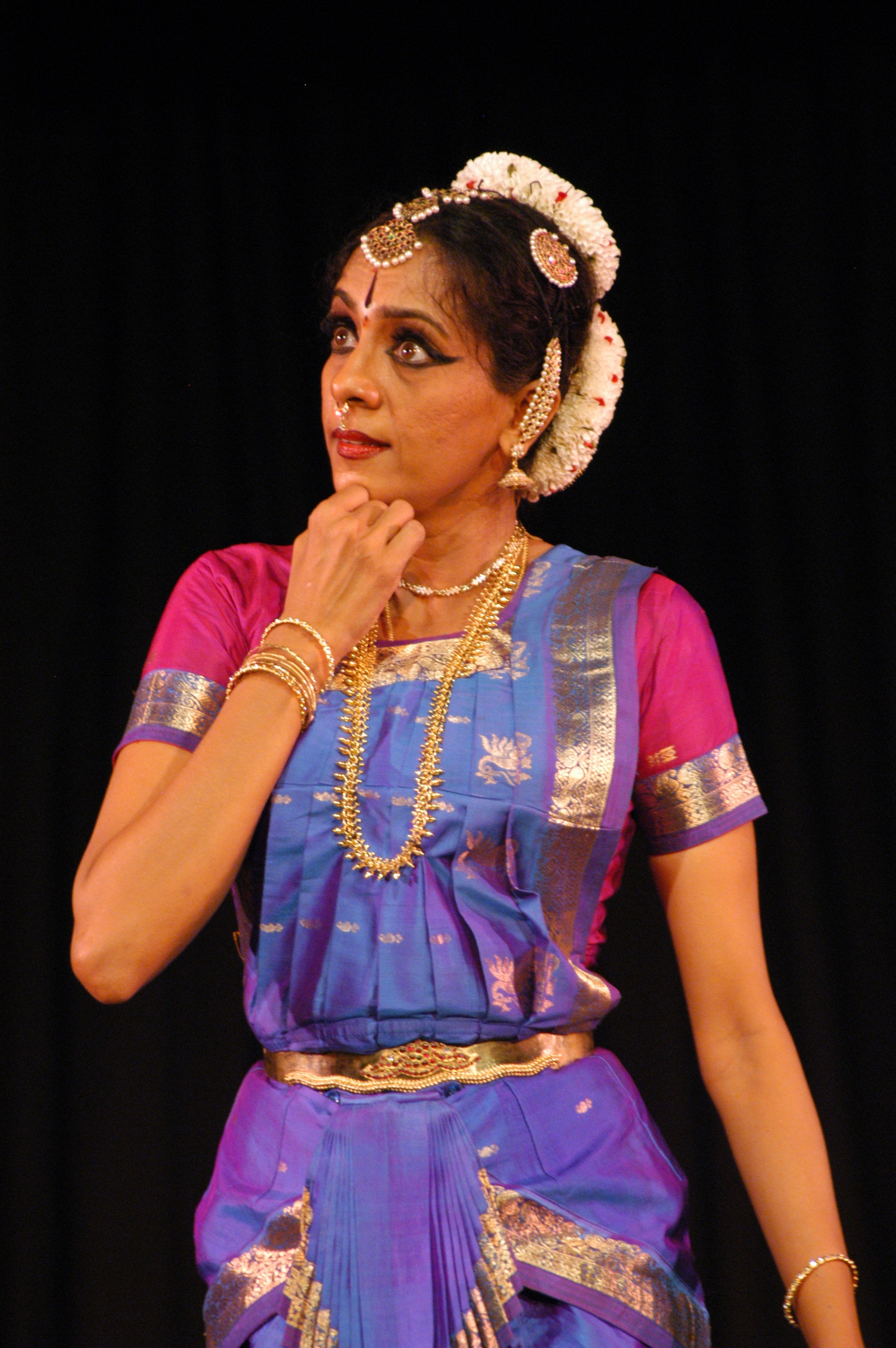

Regarding the expressive
potential of Bharatanaytam, Rukmini Devi wrote, “Bharata Natyam … is at the
same time the art of the stage, drama, music, poetry, color, and rhythm. Its
keynote is the dance which includes all the arts but whose message is not
merely to the senses, and through them to a purely external enjoyment, but is
to the soul of the dancer and the perceiver. Because of this message, Bharata
Natyam is meant primarily for spiritual expression. It cannot be adequately
danced by anyone without reverence for technique and for spiritual life.” The
idea that a dancer must enter the spirit of the dance, to experience inwardly
what is to be expressed through dance, is echoed in the words of
Meenakshisundaram Pillai, Rukmini Devi’s dance guru, who stated, “Bharatanatyam
is an art which purifies the mind, speech, and body, and elevates the performer
to a realization of the Supreme through the perfect blending of music, rhythm,
and emotion.” This statement implies that the art form itself can be a
technique for spiritual development. In a similar vein, Balasaraswati said,
“Bharatanatyam is an art, which consecrates the body, which is considered to be
in itself of no value. The yogi, by controlling his breath and by modifying his
body, acquires the halo of sanctity. Even so, the dancer, who dissolves her
identity in rhythm and music, makes her body an instrument, at least for the
duration of the dance, for the experience and expression of the spirit.” We
know these descriptions are not just self-aggrandizing words, because so many
who witnessed performances by Rukmini Devi and by Balasaraswati felt the
presence of something beyond the form of the dancer. When Balasaraswati
portrayed Krishna, there were those who felt that Krishna was really there.
When Rukmini Devi danced as Parvati, many observers had the experience of a
divine presence.

Learning Bharatanatyam
Bharatanatyam is an art
form with considerable depth and scope. One can devote a lifetime to becoming
expert at it. It is rare that students in the West have such time to dedicate
to learning the arts, especially outside a university setting. While it’s
possible to learn about Bharatanatyam
at some universities, their curricula aren’t designed to create dancers.
Rangashree aims to create dancers.
The first section of this
page describes the progression of a Bharatanatyam dance student at
Rangashree. Developing dancers go through various stages or milestones, which
are
- beginners or children,
- intermediates,
- advanced students,
- the arangetram,
- post arangetram students, and
- experts doing further study.
This section will help you
understand what to expect at these stages, and show you how far you can go.Progression
This will be a brief
overview of the different stages in the development of a dancer, as approached
at Rangashree. It's not a complete description of the training curriculum. It's
just to give an idea of what a student can expect at various stages.
Training for Bharatanatyam
can begin after a child is five years old. Any adult with the requisite
physical flexibility and stamina can take it up too. Let's see what follows.
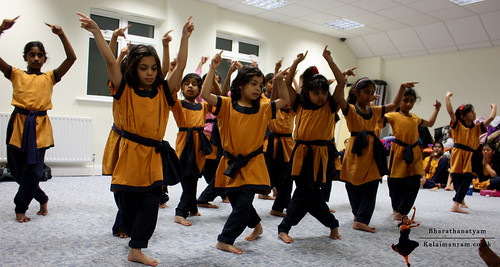
The early stages of
training involve learning the basic steps, called adavus, and movements of the
dance. These elements are the building blocks for subsequent, more advanced,
sequences of dance. The exercises condition the body for the unique postures of
Bharatanatyam. They also develop the student's sense of rhythm. Having a fit
and flexible physique allows a student to learn quickly; otherwise the fitness
and flexibility will have to be developed over time.
Students also learn eye
movements, which are done in synchronization with body movements in the dance.
At this stage, students
also learn the names of hand gestures called hastas, which are an important
feature of Bharatanatyam. They comprise the descriptive language of the dance.
Students also learn about the history of Bharatanatyam, the musical instruments
used, and other related topics.
Beginning students of
Bharatanatyam also learn folk dances. The folk dances are group dances, and
complement the classical training, which is for solo dancing at this stage.
They teach the students coordination with other dancers. They also let students
get a taste of performing on stage.
At the intermediate stage,
students learn more advanced steps and complicated patterns of movement. They
also learn the names of facial expressions, which are a distinctive feature of
Bharatanatyam.


The students begin learning
some basic dance compositions. The choreography is simple, and there isn't much
expressive content. Examples of these items are thealarippu and jatiswaram. These items may be
performed on stage at student shows and Rangashree's annual function.
Folk dance training
continues, and includes more complex choreography. By performing folk dances at
different occasions during the year, students get comfortable about being on
stage.
These students learn the
remaining dance compositions that make up the repertoire of a full
Bharatanatyam recital. Although they may only learn a single instance of some
types of items, the repertoire covers all the features of the dance. It
includes rhythmic dance, emotional expression, and variety. The items they
practice include the shabdam, varnam, padam, kirtanam, ashtapadi, javali, tillana, and shlokam.

Advanced students perform
Bharatanatyam on stage at various times during the year, to gain experience.
They are in preparation for the arangetram, which marks their coming
of age as dancers. They need to develop proficiency in all aspects of the
dance.
Folk dance training and
performing continues, since it's good experience (and fun).
This milestone in the
career of a Bharatanatyam dancer is often misunderstood as the graduation event
that ends the training of the dancer. It is actually a beginning of the
dancer's career as a performer, and there's no end to the training afterwards.
The word arangetram translates
as climbing onto (etram) the
stage (arangam).

The arangetram is marked by a solo
recital by the new dancer, attended by the teacher, mentors, and family elders.
It's up to the dancer as to how large a function it is, and who else attends.
The trend in recent years to extravagant arangetramfunctions is unfortunate,
since the lavish arrangements often distract attention from the dance
performance. The real point of the arangetram is for the dancer to
deliver his or her first full solo performance, and receive the blessings of
the teacher and other elders for a fruitful dance career. There have been top
dancers in Bharatanatyam whose arangetram performances were
attended by only a handful of people.
By the time of the arangetram, the dancer will have
learned all the elements of the dance, and demonstrates this knowledge and
ability in the arangetram recital.
After the arangetram, the dancer can mature and
develop further as a performer. More compositions can be learned, expanding the
repertoire that the dancer can perform. By performing regularly, the dancer
becomes aware of his or her strengths and weaknesses, and can work with the
teacher to improve the weak areas, as well as to choreograph items that capitalize
on the strong areas.
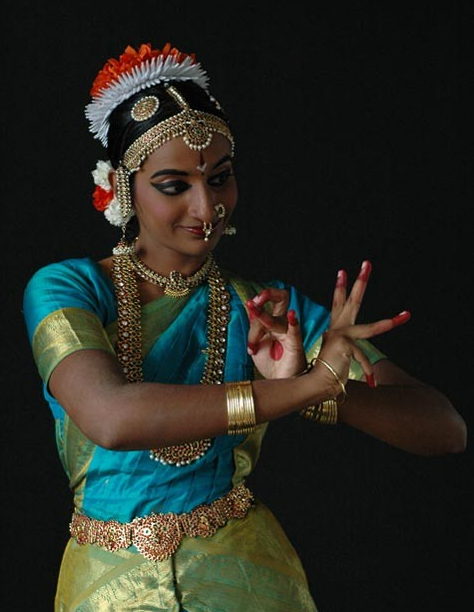

Note that dancers who
studied elsewhere and completed the arangetram may still have basic
elements to learn to complete their training.
A seasoned performer can
venture into choreographing new items. A teacher can be helpful in this
process, bringing experience of what works and what doesn't.
Experienced dancers can
also begin teaching others. It's a good way to solidify one's own skills.
A dancer who has completed
all the training that one teacher can offer, who has gained experience
performing, and perhaps has even started teaching, can benefit from further
studies. Working with other artists can provide fresh ideas and perspectives.
Training under other teachers can broaden the dancer's skills or add specific
new abilities. If it hasn't happened already by this stage, the dancer may also
benefit from traveling to India or practicing there for some time.
By this point, the dancer
is charting his or her own course as an artist. It is still important to
continue to grow, and every new experience has the potential to inform the
dancer's artistic expression. All avenues for expression are now open to the
dancer - performing, composing, teaching, and perhaps even broadening the scope
of the dance.
§
The classical dances of
India were maintained for centuries using a system of training that fit the
culture of that time and place. Today, society is different, even in India. The
old systems of training don't fit with modern lifestyles. Perhaps by being
aware of some key aspects of the traditional approach to training, we can build
on the opportunities that are available today.


In India, traditional
knowledge was passed from teachers to disciples using a system called the gurukul. The literal meaning
of gurukul is
"the guru's family". Students would live with the teacher for
extended periods, during which they not only learned skills, but also imbibed
the personal qualities or spirit of the guru. Thus they would practice their
arts with the same intention as the guru. This system preserved the spirit of
Indian arts and culture for millennia.
In the last few hundred
years, the gurukul system
has all but disappeared. Fortunately, at least in India, the idea that a
student of classical arts must dedicate a major part of his or her life to
properly learn the art does remain. This is seen most often with classical
music. There are some examples from the world of dance, as well.
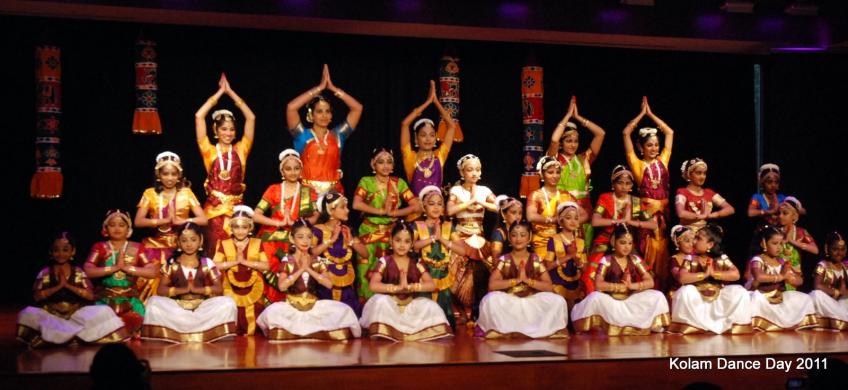
Bibliography
Sambamoorti, P., “The
Musical Content of Bharata Natyam.” Classical and Folk Dances of India. Bombay:
Marg Publications, 1963.
Rukmini Devi, “The
Spiritual Background of Bharata Natyam.” Classical and Folk Dances of India. Bombay:
Marg Publications, 1963.
Iyer, E. Krishna, “A Note
on the Repertory from Alaripu to Tillana.” Classical and Folk Dances of India. Bombay:
Marg Publications, 1963.
Kothari, Sunil, Bharata Natyam. Mumbai: Marg
Publications, 2000.
Rukmini
Devi Arundale Birth Centenary Volume. Chennai: The Kalakshetra
Foundation, 2004
Devi, Ragini, Dance Dialects of India. Delhi: Motilal
Banarsidass, 2002.
Rani, Kamala, Essence of Nattuvangam, Bharatanatyam Guide Book.
Chennai: Kamala Rani, 1997.
Rani, Kamala, Nattuvangam Book-1 100 Roopaka Thalam Theermanams.
Chennai: Kamala Rani, 1997.
Rani, Kamala, Nattuvangam Book-2 101 Aadhi Thalam Theermanams.
Chennai: Kamala Rani, 1997.
Balasaraswati,
T., Translation of her Speech on Bharata Natyam. Madras: Presidential
Address, Tamil Isai Sangam Conference, 1975
Asamyukta
Hasta or Single Hand Gesture
Asamyukta hastas are done
using single hand. The Natyshastra mentions about 28 Mudras ie upto Trishula
Mudra. There are four new mudra added to this list ie Kataka, Vyagraha,
Ardhasuchi and Palli. These Hand Gestures are a Part of Angika Abhinaya. I
shall be explaining each of these Mudras with reference to the shlokas of
Abhinayadarpana.


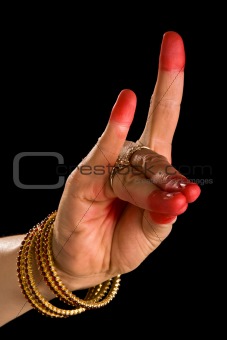
Following are the list of all the Single hand Gesture.



Following are the list of all the Single hand Gesture.
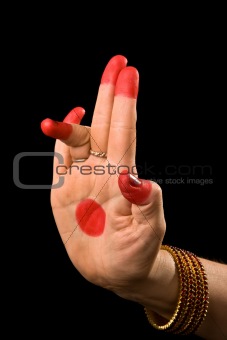
1. Pataka
2. Tripataka
3. Ardhapataka
4. Kartarimukha
5. Mayura
6. Ardhachandra
7. Arala
8. Shukatunda
9. Mushthi
10.
Shikhara
11.
Kapitta
12.
Katakamukha
13.
Suchi
14.
Chandrakala
15.
Padmakosha
16.
Sarpashirsha
17.
Mrigashirsha
18.
Simhamukha
19.
Kangula
20.
Alapadma
21.
Chatura
22.
Bhramara
23.
Hamsasye
24.
Hansapakshika
25.
Sandamsha
26.
Mukula
27.
Tamrachuda
28.
Trishula
29.
Ardhasuchi
30.
Vyagraha
31.
Palli
32.
Kataka

Samayukta
Hastas or Double Hand Gestures in Bharatanatyam
Samyukta Hastas are also
called as Double hand gestures or Combined hand gestures. Unlike Asamyukta
hastas, these gestures require use of both the palms to convey the message or a
particular meaning. For example the Anjali Mudra is a simple gesture where both
the palms are joined to mean a Namskara or to imply salutations. I have also
put some images of double hand gestures. Each gestures has its own uses which
is termed as Viniyoga. I am writing a separate post on each of these mudras.

1. Anjali
2. Kapota
3. Karkata
4. Swastika
5. Dola


6. Pushpaputa
7. Utsanga
8. Shivalinga
9. Kataka-vardhana
10. Kartari-swastika
11. Shakata
12. Shankha
13. Chakra

14. Pasha
15. Kilaka
16. Samputa
17. Matsya
18. Kurma
19. Varaha
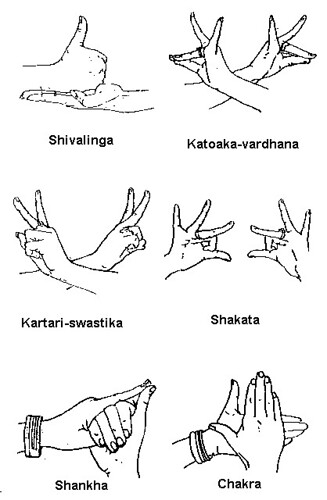
20. Garuda
21. Nagabandha
22. Khatava
23. Bhairunda
24. Avahitta
Subscribe to:
Comments (Atom)
Loading...
Custom Slideshows.
